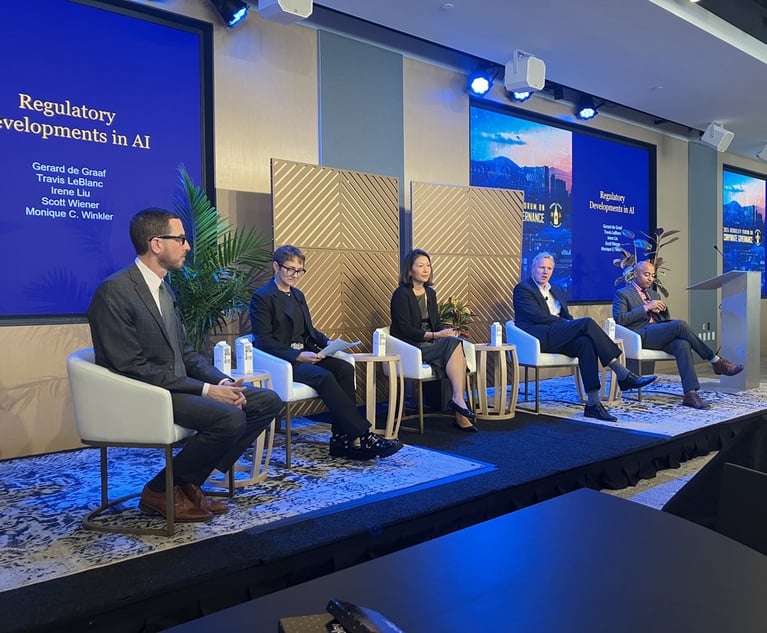Breaking Down the Barriers to Information Governance Automation
At ILTACON 2017, law firm and professional services leaders discuss their experiences automating parts of the information governance workflow.Automation…
August 24, 2017 at 09:12 PM
5 minute read
The original version of this story was published on Law.com
At ILTACON 2017, law firm and professional services leaders discuss their experiences automating parts of the information governance workflow.
Automation is being touted as the savior for various legal workflows, with information governance (IG) prevalent among them. At the International Legal Technology Association's 2017 ILTACON Conference, leaders from Am Law 100 firms and a professional services group discussed their own experiences automating components of IG and suggested other areas ripe for automation.
|The Obstacles to Automation
As it stands, the legal workflow isn't entirely conducive to full automation. “The challenge is at law firms, there are full stops to automation,” said Julie Colgan, strategy and innovation chief at DTI Management Solutions. She also noted that law firms, at some point, need to insert humans into the process.
Further, an obstacle to automation for law firms is culture. “When you're talking about automating various processes, culturally you have to hope your firm is comfortable with the fact that there's going to be less humans involved in the process,” said Brianne Aul, firmwide senior records and information governance manager at Morgan, Lewis & Bockius.
Aul, who previously worked in records management for Reed Smith for a little over 10 years, noted the importance of building a level of comfort around technology adoption. She suggested to ask yourself: Is there someone making sure things are being done efficiently?
Indeed, cultural change can be a formidable obstacle to automation. Change management is key, and Leigh Isaacs, director of records and information governance at White & Case, suggested finding the “people you have to engage” to get necessary information as well as buy-in from the firm. She said it's necessary to be sensitive to people whose jobs will be impacted and how you work with them.
“There is that concern that if you make things more efficient, [those affected by automation] wonder, 'What am I going to do, and what does this mean to me?'” Isaacs added.
Another roadblock to law firm automation is the specialized processes behind different workflows. As Colgan put it, one can't “just apply the same solution across the board,” as they “have to deal with technical feasibility.”
Colgan also cited loss of control as a concern around automation. She said to consider how an attorney may be sensitive to their client's case outcome, and how automation might impact that.
Aul noted that this extends all the way to the administration side. “You're automating something that's in their bank of knowledge,” she said. “They've relied on being the go-to guy or gal for many years, [and it] isn't going to carry the same amount of value.”
|Deciding on What to Automate
Before going all in with automation, decisionmakers should first identify their core processes, said Isaacs. You “need to figure out what it is you need and want to do.”
Isaacs, who was previously records and information governance director at Orrick, Herrington & Sutcliffe, also advised to identify potential areas of risk. “If it's things like outside counsel guidelines and litigation holds, [those] may be areas you want to focus on sooner rather than later, because the stakes are high if you have gaps in the way you're doing things.”
It's also important to have conversations with key decisionmakers about what realistically can be automated. Colgan noted that one should “make sure they're good processes in the first place” to ensure that applying technology to them is actually worth it. She noted that while processes such as those around depositions and threat detection might be difficult for full automation, they might be good for partial automation.
Isaacs described her own experience with partial automation when monitoring systems for questionable employee behavior, data leakage and monitoring activities in her firm's document management system. She said she had worked with her IT team to write a partially automated SQL report that generated every day, filtering through certain information for humans to look over and decide on. This approach, she said, was a step in the direction of getting things going on a day-to-day basis. In one instance, it found a patent attorney was getting ready to leave and take 5,000 documents from the firm, after which the firm called the local police department and had the attorney arrested for theft.
Another area potentially ripe for automation is email management. Isaacs noted that this automation is useful when coupled with analytics, given the volume of email on servers, as keeping up could be a “very painful process.”
She said that automation could even be useful for cleaning junk mail out of the inbox, or to help enforce a policy on deleting email blasts. This, Isaacs noted, shouldn't be “putting the hammer down” on attorneys, but rather a “way to pick away at the email beast.”
Aul said that litigation holds can be “semi-automated,” applied toward sending notifications and reminders. Further, automation in this sense would demonstrate compliance.
“This is a process that can be pretty unwieldy depending on … how many holds you have in a given year,” she added.
Colgan, meanwhile, pointed to the e-signature as an area for application. “If you're really going to [make] your law firm digital, you have to stop wet inking things,” she said. Colgan noted that this can be applied not just toward contracts, but also employee onboarding, or anything where you need an approval.
Contact Ian Lopez at [email protected].
This content has been archived. It is available through our partners, LexisNexis® and Bloomberg Law.
To view this content, please continue to their sites.
Not a Lexis Subscriber?
Subscribe Now
Not a Bloomberg Law Subscriber?
Subscribe Now
NOT FOR REPRINT
© 2025 ALM Global, LLC, All Rights Reserved. Request academic re-use from www.copyright.com. All other uses, submit a request to [email protected]. For more information visit Asset & Logo Licensing.
You Might Like
View All
Fatal Shooting of CEO Sets Off Scramble to Reassess Executive Security
5 minute read
Ben & Jerry’s Accuses Corporate Parent of ‘Silencing’ Support for Palestinian Rights
3 minute read
Shareholder Activists Poised to Pounce in 2025. Is Your Board Ready?

Regulatory Upheaval Is Coming. How Businesses Prepare and Respond Will Separate Winners and Losers
Trending Stories
- 1People in the News—Jan. 8, 2025—Stevens & Lee, Ogletree Deakins
- 2How I Made Partner: 'Avoid Getting Stuck in a Moment,' Says Federico Cuadra Del Carmen of Baker McKenzie
- 3Legal Departments Dinged for Acquiescing to Rate Hikes That 'Defy Gravity'
- 4Spalding Jurors Return $12M Verdict Against State Farm Insurance Client
- 5Special Series Part 3: The Statutory Guardrails Violate the Majority Vote Rule
Who Got The Work
Michael G. Bongiorno, Andrew Scott Dulberg and Elizabeth E. Driscoll from Wilmer Cutler Pickering Hale and Dorr have stepped in to represent Symbotic Inc., an A.I.-enabled technology platform that focuses on increasing supply chain efficiency, and other defendants in a pending shareholder derivative lawsuit. The case, filed Oct. 2 in Massachusetts District Court by the Brown Law Firm on behalf of Stephen Austen, accuses certain officers and directors of misleading investors in regard to Symbotic's potential for margin growth by failing to disclose that the company was not equipped to timely deploy its systems or manage expenses through project delays. The case, assigned to U.S. District Judge Nathaniel M. Gorton, is 1:24-cv-12522, Austen v. Cohen et al.
Who Got The Work
Edmund Polubinski and Marie Killmond of Davis Polk & Wardwell have entered appearances for data platform software development company MongoDB and other defendants in a pending shareholder derivative lawsuit. The action, filed Oct. 7 in New York Southern District Court by the Brown Law Firm, accuses the company's directors and/or officers of falsely expressing confidence in the company’s restructuring of its sales incentive plan and downplaying the severity of decreases in its upfront commitments. The case is 1:24-cv-07594, Roy v. Ittycheria et al.
Who Got The Work
Amy O. Bruchs and Kurt F. Ellison of Michael Best & Friedrich have entered appearances for Epic Systems Corp. in a pending employment discrimination lawsuit. The suit was filed Sept. 7 in Wisconsin Western District Court by Levine Eisberner LLC and Siri & Glimstad on behalf of a project manager who claims that he was wrongfully terminated after applying for a religious exemption to the defendant's COVID-19 vaccine mandate. The case, assigned to U.S. Magistrate Judge Anita Marie Boor, is 3:24-cv-00630, Secker, Nathan v. Epic Systems Corporation.
Who Got The Work
David X. Sullivan, Thomas J. Finn and Gregory A. Hall from McCarter & English have entered appearances for Sunrun Installation Services in a pending civil rights lawsuit. The complaint was filed Sept. 4 in Connecticut District Court by attorney Robert M. Berke on behalf of former employee George Edward Steins, who was arrested and charged with employing an unregistered home improvement salesperson. The complaint alleges that had Sunrun informed the Connecticut Department of Consumer Protection that the plaintiff's employment had ended in 2017 and that he no longer held Sunrun's home improvement contractor license, he would not have been hit with charges, which were dismissed in May 2024. The case, assigned to U.S. District Judge Jeffrey A. Meyer, is 3:24-cv-01423, Steins v. Sunrun, Inc. et al.
Who Got The Work
Greenberg Traurig shareholder Joshua L. Raskin has entered an appearance for boohoo.com UK Ltd. in a pending patent infringement lawsuit. The suit, filed Sept. 3 in Texas Eastern District Court by Rozier Hardt McDonough on behalf of Alto Dynamics, asserts five patents related to an online shopping platform. The case, assigned to U.S. District Judge Rodney Gilstrap, is 2:24-cv-00719, Alto Dynamics, LLC v. boohoo.com UK Limited.
Featured Firms
Law Offices of Gary Martin Hays & Associates, P.C.
(470) 294-1674
Law Offices of Mark E. Salomone
(857) 444-6468
Smith & Hassler
(713) 739-1250






